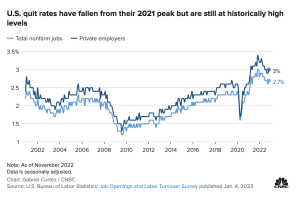At the start of last year, it appeared as if quit rates would fall. And sure enough, they did. But any optimism that quitting would drop to pre-pandemic levels is now evaporating.
According to Indeed’s latest data, quitting continued to hover above pre-pandemic levels. While not as high as it was at the end of 2021, the rate of people leaving their jobs is nonetheless higher than many employers would like.
Quitting in November last year was 16% higher than the average of 2019. (The leisure and hospitality industry in particular is experiencing persistently higher quit rates.) What’s more, the quit rate in November was higher than in October — significant because that marks the first time since March 2022 that the number went up.
As the U.S. Department of Labor shows, the quits rate among U.S. workers was 2.7% in November (which translates to about 4.2 million workers who left their roles. This was 0.1% higher than the prior month. So yes, while the quit rate has fallen since it’s peak in early 2021, as CNBC shows, the rates remain at historically high levels.

A consequence of the quit rates is the growth of wages; people usually leave for jobs that pay more. As the Federal Reserve Bank of Atlanta reports, individuals moving to a new job saw an average of 7.7% increase in pay, whereas those who remained in their roles saw a 5.5% rise in their wages. That 2.2-point spread is
Lastly, as Indeed points out, the “flipside of workers leaving their old jobs readily is that employers aren’t letting go of the workers that remain. The layoffs rate continues to stay very low at less than one percent. November was the 21st straight month that the layoffs rate was below its all-time low prior to 2020.”
